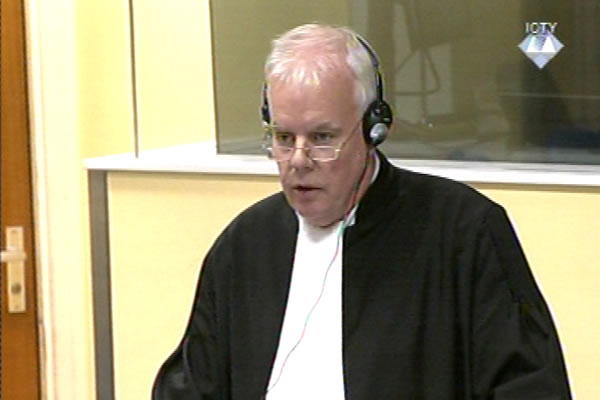Home
PROSECUTION REFUSES TO GIVE UP ON TOMASICA
The prosecution has countered the defense’s arguments that the Tomasica evidence is irrelevant and would lead to significant delays in the trial, saying that the delays would be reduced if the defense started the preparations now. The evidence is relevant, the prosecution stressed, because it shows the involvement of the Bosnian Serb army under the command of the accused in the Prijedor crimes
 Dermot Groome, prosecutor at the Ratko Mladic trial
Dermot Groome, prosecutor at the Ratko Mladic trial Last week, Ratko Mladic’s defense opposed the prosecution’s motion to re-open its case to call evidence on the Tomasica mass grave near Prijedor. In its response, the prosecution asked the judges to reject the defense arguments, focusing on three sets of those arguments.
First, the defense argued that the prosecution failed to conduct an investigation without delay, as evidenced by the fact that the motion to re-open the case was submitted in August 2014 while the mass grave was discovered in November 2013, almost a year earlier. In the response, the prosecution explains that the exhumation of bodies was completed in December 2013; by January 2014, the first witness gave a statement. All other potential witnesses were interviewed by July 2014. The motion to call the Tomasica evidence was filed as soon as all those steps had been taken. The defense was informed about the prosecution’s intention to re-open its case in November 2013.
Second, the prosecution disagrees with the defense about ‘significant delays in the trial’ that would result if the Tomasica evidence were to be called. Any such claims are ‘speculative and uncorroborated’, the prosecution argues. In their motion, the defense stressed that the proceedings would have to be delayed in order to allow the defense to prepare for the cross-examination of prosecution witnesses and to present its own Tomasica evidence. Today the prosecution noted that the defense could begin its preparations now and to complete them in the upcoming months.
In their motion seeking to reject the motion to re-open the prosecution case the defense recalled that a similar request had been denied at Radovan Karadzic’s trial. In the prosecution’s view, this comparison was ‘inappropriate and incorrect’. The prosecution recalls that when the motion was submitted in Karadzic’s case the Tomasica evidence was not yet available. Karadzic’s trial was in the ‘late stages’, nearing its end, which is not the case with Mladic’s trial, the prosecution notes.
Finally, the defense argued that the Tomasica evidence was ‘irrelevant and without any probative value’. According to the prosecution, that is not the case. The information pertaining to the mass grave shows the involvement of the Bosnian Serb army under the command of the accused in the operations to ‘kill, bury and transfer bodies’ in the Prijedor area. The location of the mass grave is mentioned in Mladic’s war diaries.
In the August 2014 motion, the prosecution indicated it would present 43 documents and call 13 witnesses on Tomasica. Seven witnesses are survivors and employees of the Ljubija mine, while six witnesses are experts. The exhumed bodies are linked with the crimes committed at several locations mentioned in the indictment against Mladic: the killings in Kozarac, Hambarine, Brdo, Biscani and nearby hamlets, as well as with the executions of prisoners in the Prijedor prison camps of Keraterm and Omarska.
Linked Reports
- Case : Mladic
- 2014-09-18 WITNESS: ‘ENGENDERING CHAOS AND VILIFYING SERBS AS MUCH AS POSSIBLE’
- 2014-09-17 AFTERMATH OF ATTACK ON AHATOVICI
- 2014-09-16 MLADIC’S WITNESS TESTIFIES ABOUT BUS MASSACRE
- 2014-09-22 ‘MY FATHER WAS CONVICTED, BUT HE IS NOT GUILTY’
- 2014-09-23 'VOLUNTARY' DEPARTURE OF MUSLIMS FROM ROGATICA
- 2014-09-24 FORCED LABOR FOR MUSLIM PRISONERS
